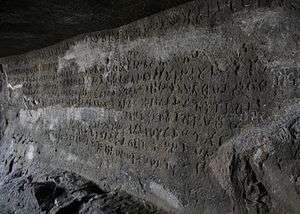Simuka
| Simuka | |
|---|---|
| Founder of Satavahana dynasty | |
| Reign | 1st century BCE |
| Successor | Kanha |
| Issue | Satakarni |
| Dynasty | Satavahana |
Simuka was an Indian king belonging to the Satavahana dynasty.[1] He is mentioned as the first king in a list of royals in a Satavahana inscription at Nanaghat.[2] In the Puranas, the name of the first Andhra (Satavahana) king is variously spelt as Sishuka, Sindhuka, Chhismaka, Shipraka, Srimukha, etc. These are believed to be corrupted spellings of "Simuka", resulting from copying and re-copying of manuscripts.[3]
Based on available evidence, Simuka cannot be dated with certainty.[4] According to one theory, he lived in 3rd century BCE; but he is generally thought to have lived in the 1st century BCE. Epigraphical evidence strongly suggests a 1st century BCE date for Simuka: Simuka seems to be mentioned as the father the acting king Satakarni in the Naneghat inscription dated to 70-60 BCE, itself considered on paleographical grounds to be posterior to the Nasik caves inscription of Kanha (probably Simuka's brother) in Cave 19, dated to 100-70 BCE.[5]
Period

| Satavahana Kings | |
| Simuka | (100-70 BCE) |
| Kanha | (70-60 BCE) |
| Satakarni | (1st BCE) |
| Sivasvati | (1st century CE) |
| Gautamiputra Satakarni | (2nd century CE) |
| Vasishthiputra Pulumavi | (2nd century CE) |
| Vashishtiputra Satakarni | (2nd century CE) |
| Shivaskanda Satakarni | (2nd century CE) |
| Yajna Sri Satakarni | (2nd century CE) |
| Vijaya | (2nd century CE) |
Simuka is mentioned as the first king in a list of royals in a Satavahana inscription at Naneghat.[2] The various Puranas have different names for the founder of the Andhra dynasty: Shishuka in Matsya Purana, Sipraka in Vishnu Purana, Sindhuka in Vayu Purana, Chhesmaka in Brahmanda Purana, and Shudraka or Suraka in Kumarika Khanda of Skanda Purana.[7] These are believed to be corrupted spellings of Simuka, resulting from copying and re-copying of manuscripts.[8]
The Matsya and Vayu Puranas mention that the first Andhra king overthrew the Kanva king Susharman (c. 40–30 BCE). Based on identification of Simuka with this king, some scholars believe that Simuka's reign started in 30 BCE. Scholars supporting this theory include D. C. Sircar, H. C. Raychaudhuri and others.[9]
The Matsya Purana mentions that the Andhra dynasty ruled for 450 years. It is known that the Satavahana rule continued till the beginning of the early 3rd century. Therefore, the beginning of the Satavahana rule can be dated to 3rd century BCE. In addition, Indica by Megasthenes (350 – 290 BCE) mentions a powerful tribe named "Andarae", whose king maintained an army of 100,000 infantry, 2,000 cavalry and 1,000 elephants. If Andarae is identified with the Andhras, this can be considered additional evidence of Satavahana rule starting in 3rd century BCE. According to this theory, Simuka was an immediate successor of the Mauryan emperor Ashoka (304–232 BCE). According to these scholars, the Kanva ruler Susharman was overthrown by a successor of Simuka. The Brahmanda Purana states: "the four Kanvas will rule the earth for 45 years; then (it) will again go to the Andhras". This indicates Satavahanas had been in power before the Kanvas subjugated them; the Kanva rule was ultimately overthrown by a Satavahana king. Scholars supporting this theory include A. S. Altekar, K. P. Jayaswal, V. A. Smith and others.[9]
According to Sudhakar Chattopadhyaya, Simuka was the person who revived the Satavahana rule after the Kanva interregnum, and thus a founder of the 'second' Satavahana dynasty; the compilers of the Puranas have confused his name with the founder of the original dynasty.[9]
According to Charles Higham, the coin-based evidence suggests that Simuka's reign ended sometime before 120 BCE.[10] Himanshu Prabha Ray also dates Simuka to somewhere before 100 BCE.[11]
Biography
Not much is known about Simuka. According to Jain legends, he adopted Jainism; but, in the last years of his life, he became a tyrant, for which he was deposed and killed.[12]
Simuka was succeeded by his brother Kanha, who further extended the empire westward at least as far as Nashik.[4][9] According to Matsya Purana, Krishna was succeeded by Mallakarni, but according to other Puranas, he was succeeded by Satakarni. The Naneghat cave inscription of Satakarni lists his family members: it mentions Simuka's name, but not that of Krishna. Based on this, historians conclude that Satakarni was Simuka's son, and succeeded Krishna.[9][13]
References
- ↑ Raychaudhuri 2006, p. 336.
- 1 2 James Burgess; Georg Bühler (1883). Report on the Elura Cave Temples and the Brahmanical and Jaina Caves in Western India. Trübner & Company. p. 69.
- ↑ Ajay Mitra Shastri (1998). The Sātavāhanas and the Western Kshatrapas: a historical framework. Dattsons. p. 42. ISBN 978-81-7192-031-0.
- 1 2 Upinder Singh (2008). A History of Ancient and Early Medieval India. Pearson Education India. pp. 381–384. ISBN 9788131711200.
- ↑ Empires: Perspectives from Archaeology and History by Susan E. Alcock p.168
- ↑ Carla M. Sinopoli 2001, p. 168.
- ↑ Fitzedward Hall, ed. (1868). The Vishnu Purana. IV. Translated by H. H. Wilson. Trübner & Co. pp. 194–202.
- ↑ Ajay Mitra Shastri (1998). The Sātavāhanas and the Western Kshatrapas: a historical framework. Dattsons. p. 42. ISBN 978-81-7192-031-0.
- 1 2 3 4 5 Sudhakar Chattopadhyaya (1974). Some Early Dynasties of South India. Motilal Banarsidass. pp. 17–56.
- ↑ Charles Higham (2009). Encyclopedia of Ancient Asian Civilizations. Infobase Publishing. p. 299. ISBN 9781438109961.
- ↑ Carla M. Sinopoli (2001). "On the edge of empire: form and substance in the Satavahana dynasty". In Susan E. Alcock. Empires: Perspectives from Archaeology and History. Cambridge University Press. pp. 166–168.
- ↑ Kambhampati Satyanarayana (1975). From stone age to feudalism. People's Publishing House. p. 111.
- ↑ Raychaudhuri 2006, p. 346.
Bibliography
- Raychaudhuri, Hemchandra (2006), Political History Of Ancient India
- Smith, Vincent Arthur, Andhra: history and coinage